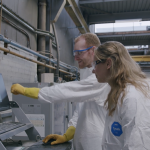Features - Business
Green trends set to shape UK building industry

The Environmental Act 2021, passed into law in November 2021, is rapidly changing the construction field by establishing a post-Brexit framework for environmental governance. This guides future legislation concerning air and water quality, biodiversity, and waste management and creates enforceable targets related to climate change.
Companies competing for government contracts worth more than £5M will have to show how they plan to achieve zero emissions by 2050. The new rules, detailed in Public Policy Note 06/21, state that businesses affected by the changes must provide a carbon reduction plan outlining how they aim to cut CO2 emissions by 80% before 2050. In addition to showcasing how critical environmental compliance is for builders and contractors, these latest developments also underscore the importance of other assessment programs, like PAS 91, and achieving the Common Assessment Standard.
These green trends will be shaping the UK construction industry in 2023, Adam Roper investigates for us.
Net-zero buildings are becoming increasingly popular
The UK government released a Net Zero Strategy in October 2021, which details how to create 440,000 jobs and invest £90Bn by 2030 while still taking strides to reduce climate change contributions by 2050.
Up to £90Bn of private investment and 440,000 well-paid jobs in green industries will be created by 2030 due to the commitments made. This will give businesses the certainty they need to support the UK’s transition to a low-carbon economy – from heat pumps to electric vehicles – and help develop thriving green industries in our industrial heartlands – from carbon capture to hydrogen. Determining a net zero strategy for construction leaders in the near future will be important. An example of this in action is McKinsey, who has created the Net Zero Built Environment Council, an alliance of industry stakeholders to determine how to reduce greenhouse emissions from buildings.
The UK Government’s Net Zero Strategy is a set of policies and financial commitments to support the ‘green industrial revolution.’ Since its launch, 26 billion pounds in clean industries has been invested, creating at least 56,000 jobs. It is also estimated that more than £5.8Bn in investment from foreign entities could be possible at the upcoming Global Investment Summit. The UK construction industry will need to determine how it can embrace net zero moving forward.
Existing buildings will be scrutinised further
Since 2008, the green building industry has focused more on repairing old buildings and occupier spaces than new construction projects. Given that new construction certification is more or less stagnant, the existing building market is getting more focus, especially energy-efficiency retrofits and a recharged interest in using the Energy Star system. LEED certification isn’t making headlines like it used to expect; however, both BREEAM and LEED certifications are to come into the fore over the next few years.
Cloud computing and Big Data are two areas that will provide valuable data
Software platforms that manage buildings remotely are growing in popularity and use as they provide performance monitoring, data analytics, visualisation, fault detection and diagnostics, portfolio energy management, and text messaging–all cloud-based.
The last few years have seen an increased number of new products and services for building automation, facility management, wireless controls, and building services information management. Additionally, energy dashboards, cheap sensors, awareness of the business case for energy upgrades, and government regulation and actions to cut energy use have grown significantly during this time.
Building performance disclosure requirements will become more stringent
Since 2010, revealing some performance to buyers, lessees, or renters has been obligatory throughout the European Union. This was due to the Energy Performance in Buildings Directive (created in 2003 but not thoroughly carried out until around 2010). Most often, the relative scale is revealed via an energy performance certificate called EPCs.
The UK government is ramping up requirements by setting forth a proposal for all non-domestic buildings to meet Energy Performance Certificate (EPC) level B levels by 2030. In addition, a second consultation has been carried out to introduce a national policy framework that will assess energy use and carbon emissions in commercial and industrial buildings yearly. The first step of this process is rating disclosure, which will be mandatory. Expect more stringent requirements to come through over the decade.
Sustainable design and construction will become even more important
The construction sector will need to play a significant role in helping the UK reach its 2050 net zero targets by embracing circular economy principles, using sustainable materials for construction, and leveraging digital technologies. Construction companies will be forced to consider new technologies such as green concrete, dynamic glass, and recycled materials to meet their green targets.
Solar power will shine through
The UK solar sector has seen strong growth during the year’s first half. A new report by Solar Energy UK estimates that the country’s solar capacity now exceeds 15GW, approaching four times the maximum output of the UK’s largest power station,
Since 2010, the price of solar panels has decreased by 60%, making it a viable investment without government subsidies. As a result, solar deployment has been steadily increasing yearly, with 2021 being the best year since 2015. In addition, the recent rise in energy prices has made solar an even more attractive option for investors.
According to Solar Energy UK, solar power could make up 15% of the UK’s energy needs by 2030 – which is almost a tripling from the current 4%. And that potential output is similar to more than ten Sizewell C nuclear power stations. Additionally, this capacity can be built on something other than entirely new land – a recent report says there is enough space for PV panels alone. In this current economic climate and fears surrounding energy prices, individuals and companies will be increasingly interested in investing in solar power to save energy.
Out of all the trends, solar power growth alone can be game-changing and liable to cause significant shaking up of how buildings are designed, built, and operated over the next ten years.
If you would like to read more stories like this, then please click here
Related Articles
More Features
- Ten years of progress on payment, pre-qualification and skills
19 May 25
The industry has made significant progress on late payment, pre-qualification, and competence since the formation
- Pagabo provides clarity on impacts of new NPPS and PPNs
12 Mar 25
The Labour government’s new National Procurement Policy Statement (NPPS) sets out strategic priorities for public
- How is the Procurement Act going to drive social value
24 Feb 25
The regulations laid out within the Procurement Act 2023 will go live today.






